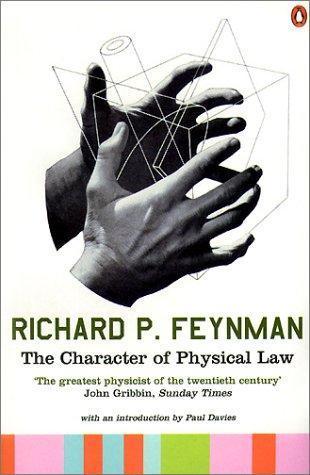Arbieroo reviewed The Character of Physical Law by Richard P. Feynman
Review of 'The Character of Physical Law' on 'Goodreads'
5 stars
This is a fantastic little book for which we have to thank the BBC: They decided to film these lectures and subsequently publish transcripts of them, at a time before Feynman had turned into a one-man industry and every one of Feynmans studentsfirst-draft lecture notes became as diamond dust.
The title tells one enough about the contents; if you have any interest in the topic you should read this book. It is almost but not completely non-mathematical. If you can cope with the algebra contained within F=GMm/R - well, that's as hard as it gets.
The aspect of the book that particularly interested me this time around is in Chapter two (and reprised somewhat in the final lecture). Feynman takes the above given equation, which expresses Newton's Law of Universal Gravitation and says - that's all very well, but you can express it in another way that's to do with …
This is a fantastic little book for which we have to thank the BBC: They decided to film these lectures and subsequently publish transcripts of them, at a time before Feynman had turned into a one-man industry and every one of Feynmans studentsfirst-draft lecture notes became as diamond dust.
The title tells one enough about the contents; if you have any interest in the topic you should read this book. It is almost but not completely non-mathematical. If you can cope with the algebra contained within F=GMm/R - well, that's as hard as it gets.
The aspect of the book that particularly interested me this time around is in Chapter two (and reprised somewhat in the final lecture). Feynman takes the above given equation, which expresses Newton's Law of Universal Gravitation and says - that's all very well, but you can express it in another way that's to do with how something called a potential varies locally - and if you do it will always give exactly the same answer! And, not content with that, you can express it another way that is to do with finding the minimum of a certain thing called the Action. (Technically it doesn't have to be a minimum, just somewhere where the tangent to the graph of the Action would be horizontal.) Done this way, the answers always come out the same as the other two ways! What's the point of that? Three ways to say the same thing!
But here's the interesting, indeed profound thing: when it came to understanding quantum mechanics (which doesn't deal with gravity) it was found that both potentials and a principle of minimum (stationary, strictly) Action were needed. So the different ways of expressing Newton's gravity law turned out profoundly useful in understanding a different set of phenomena, namely the nuclear forces and electromagnetism.
So if you are involved in trying to understand fundamental physics it would probably be healthy to actively search for different mathematical methods of expressing the laws as we understand them now!
Incidently, I doubt you will ever come across a more accessible introduction to the essential mystery of quantum mechanics (the photon/electron double slit experiment) than that given in this lecture, in which Feynman gave his famous quote, "...I think I can safely say nobody understands quantum mechanics."

